Welcome to the unique and beautiful Palmyra Atoll! This remote, isolated atoll located in the North Pacific Ocean is home to a variety of birds that can only be found here.
From the majestic Frigatebird to the graceful White Tern, Palmyra Atoll is a paradise for birdwatchers, offering a glimpse into the unique avian world. With over 100 species of birds recorded on the atoll, this is one of the most biologically diverse places on the planet.
Whether you’re hoping to spot a rare endemic species or just enjoy some breathtaking birdwatching, Palmyra Atoll is the perfect place to explore.
1. Cattle Egret
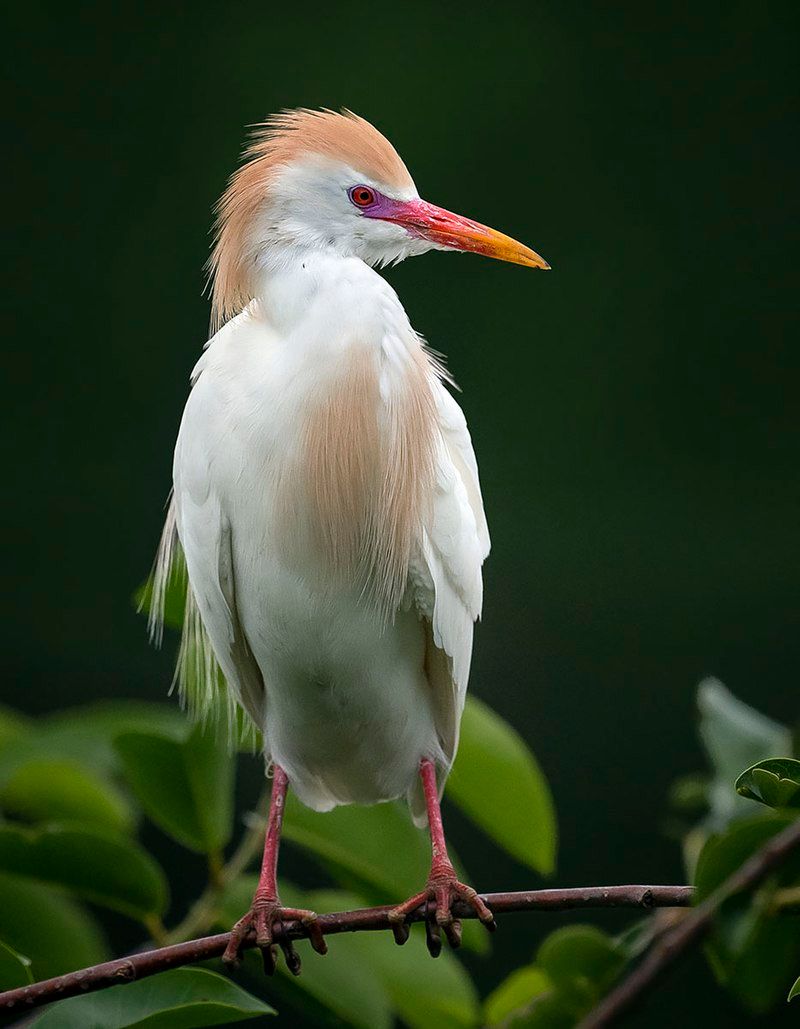
The cattle egret is a unique species of heron, widespread across the tropics, subtropics, and warm-temperate zones. It is the only member of the monotypic genus Bubulcus, meaning it is the only species in this genus.
However, some experts consider the cattle egret to have two distinct subspecies – the western cattle egret and the eastern cattle egret – and classify them both as full species, distinct from one another.
The western cattle egret is found around Africa, Europe, and parts of Asia, while the eastern cattle egret inhabits areas ranging from India and Southeast Asia to New Guinea and parts of Australia. Both subspecies are white in color and have a yellow bill and black legs.
They are usually found near pastures and wetlands, where they feed on insects, frogs, and small fish. The cattle egret is a very successful species, capable of inhabiting a wide range of habitats. It is also very adaptable, being able to live in both rural and urban areas.
Additionally, it is a very social bird, often forming large colonies with other herons and egrets. Overall, the cattle egret is a widespread and adaptable species of heron, and its two subspecies provide further evidence of its success and diversity.
| Kingdom | Animalia |
| Phylum | Chordata |
| Class | Aves |
| Order | Pelecaniformes |
| Family | Ardeidae |
| Genus | Bubulcus |
| Species | B. ibis |
2. Great Frigatebird
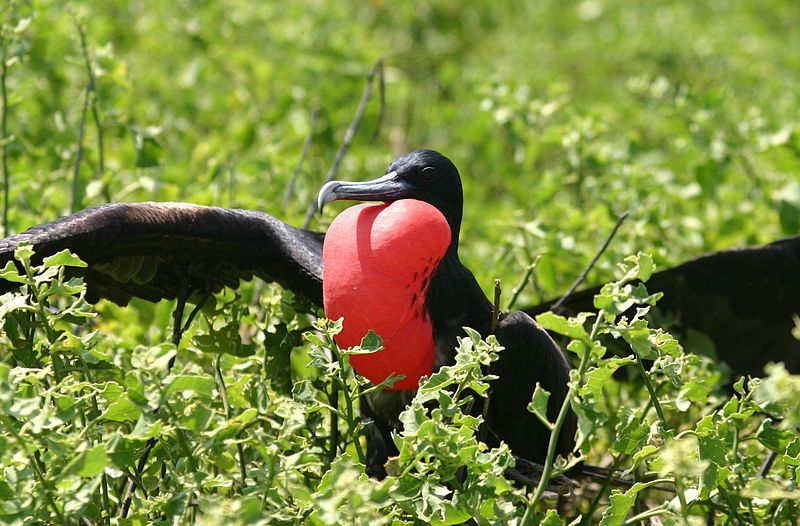
The great frigatebird is a large seabird that belongs to the frigatebird family. It is known for its impressive wingspan, which can reach up to 2.3 meters, allowing them to soar for long distances.
They are commonly found in the tropical Pacific Ocean, including places such as Hawaii and the Galápagos Islands. Additionally, they nest in the Indian Ocean, around the Cocos Islands, Christmas Island, Chagos Archipelago, and the Seychelles.
They also inhabit the Atlantic Ocean, near the coasts of Brazil, Argentina, and Uruguay. Frigatebirds are unique in that they do not have waterproof feathers, making it difficult for them to swim.
Instead, they feed by snatching food from the surface of the water or by stealing it from other sea birds. They mainly feed on small fish, squid, and jellyfish. Frigatebirds are social birds that tend to form large flocks.
However, the birds can become quite territorial, especially during the breeding season.
During this time, the males will try to attract a mate by inflating their red throat pouch, a behavior known as “ballooning.” They will also engage in aerial displays, such as hovering and swooping in mid-air.
The great frigatebird is a remarkable animal that is highly adapted to its marine environment. Its ability to soar for long distances and its unique feeding behavior make it a fascinating species to observe.
| Kingdom | Animalia |
| Phylum | Chordata |
| Class | Aves |
| Order | Suliformes |
| Family | Fregatidae |
| Genus | Fregata |
| Species | F. minor |
3. Red-footed Booby
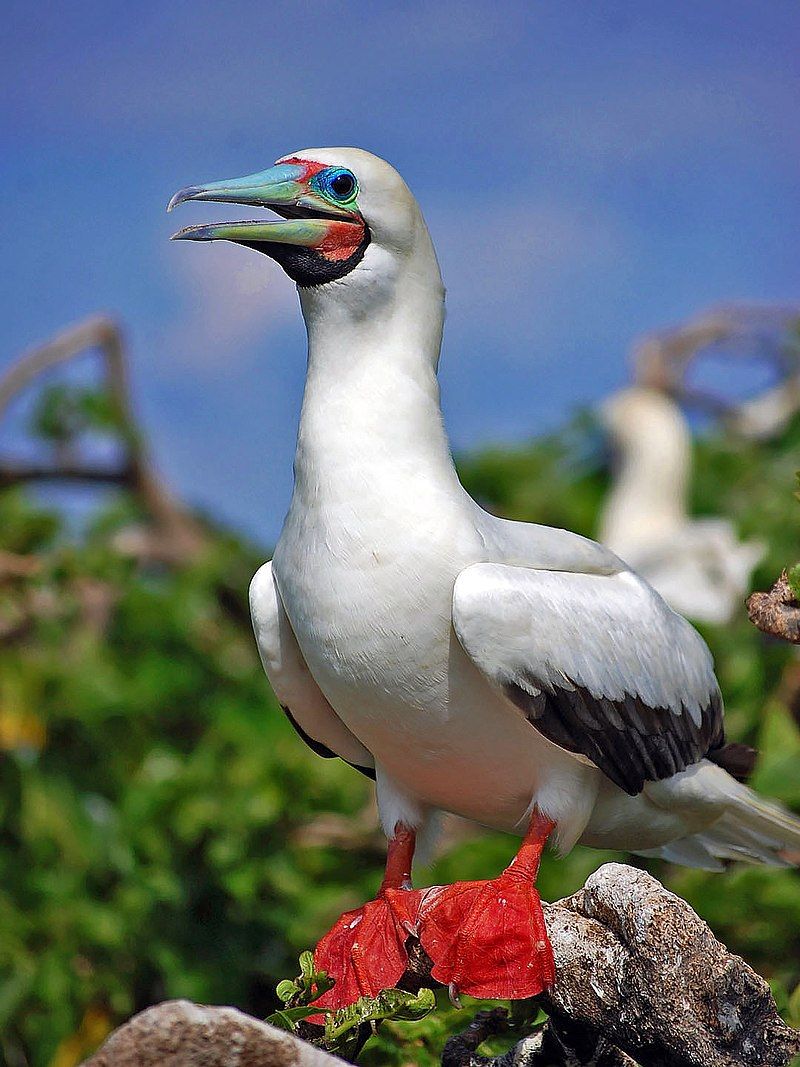
The red-footed booby is a large seabird belonging to the booby family, Sulidae. This species is easily recognized by its distinct red feet. However, the color of its plumage can vary.
Red-footed boobies are very skilled fliers, capable of powerful and agile maneuvers, although they tend to be clumsy during takeoffs and landings. These birds are widely distributed in tropical areas, where they form large colonies in coastal environments, especially on islands.
Red-footed boobies have strong and versatile wings that allow them to reach high speeds and travel long distances. They feed mainly on fish, which they catch by diving in the air. They also feed on squid and crustaceans.
The red-footed booby is an important species in the ecosystem, as it helps keep the populations of its prey species in balance.
| Kingdom | Animalia |
| Phylum | Chordata |
| Class | Aves |
| Order | Suliformes |
| Family | Sulidae |
| Genus | Sula |
| Species | S. sula |
4. Brown Noddy
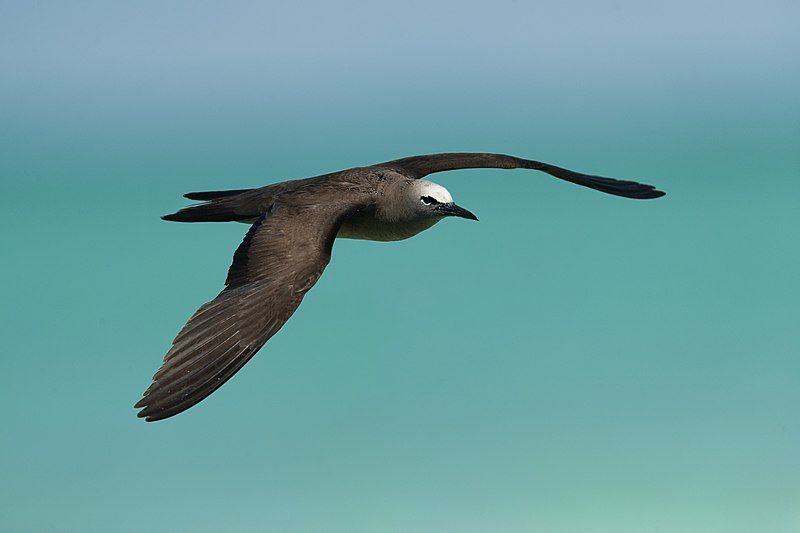
The Brown Noddy is a seabird belonging to the family of Laridae. It is the largest of the noddies and can easily be distinguished from the closely related Black Noddy by its larger size and distinct plumage.
The Brown Noddy’s plumage is dark brown in color whereas the Black Noddy’s plumage is black.
This species of seabird can be found in tropical and subtropical regions of the world, such as the Caribbean, Atlantic, and Pacific oceans. The Brown Noddy has a typical tern body shape with a long, pointed beak, long wings, and a long, forked tail.
Its plumage is light gray on the head and upperparts, and white on the underside. Its legs are yellowish-brown and its eyes are dark brown.
The Brown Noddy typically feeds on small fish and crustaceans, which it catches by plunge-diving from a height. The Brown Noddy is a highly social bird and can often be seen in large flocks, usually numbering in the hundreds.
It nests in colonies and can be found roosting in trees or shrubs near the shore.
The Brown Noddy is an important species in the food chain as it helps to keep the population of small fish and crustaceans in check. Overall, the Brown Noddy is a stunning seabird species with its distinct brown plumage and its social behavior.
It is an important species to the environment and it is important to protect its habitat in order to ensure its future survival.
| Kingdom | Animalia |
| Phylum | Chordata |
| Class | Aves |
| Order | Charadriiformes |
| Family | Laridae |
| Genus | Anous |
| Species | A. stolidus |
5. Sooty Tern
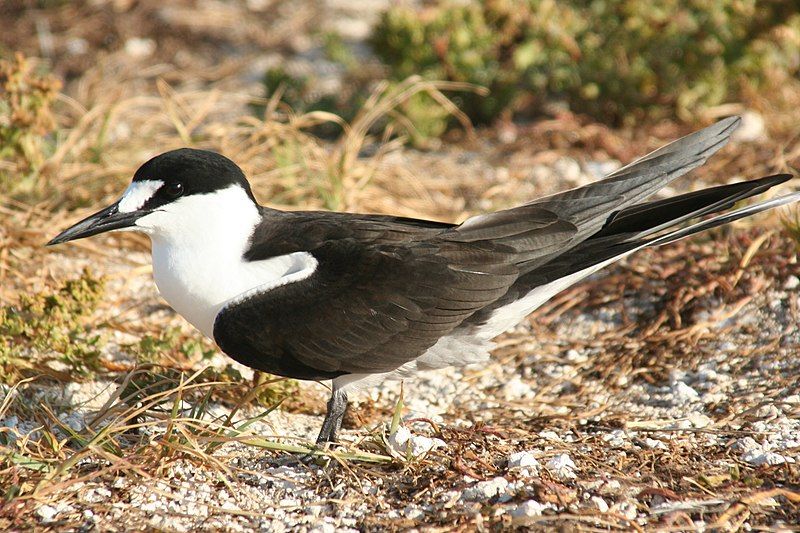
The sooty tern is a seabird of the family Laridae, which is usually found in tropical oceans. This species of bird is highly adapted to living primarily in the ocean, only returning to land for the purpose of breeding on islands located within the equatorial zone.
The sooty tern is a migratory species, traveling from the northern and southern hemispheres of the earth, depending on the season. This bird is usually seen in large groups, with colonies often found on uninhabited islands.
The sooty tern has a unique diet, consisting mainly of fish, squid, and crustaceans, which it hunts during its time at sea. It has a highly distinguishable appearance, with its black head, wings, and tail contrasting with its otherwise white body.
The sooty tern plays an important role in the global ecosystem, as it helps to keep the population of small fish and invertebrates in check.
| Kingdom | Animalia |
| Phylum | Chordata |
| Class | Aves |
| Order | Charadriiformes |
| Family | Laridae |
| Genus | Onychoprion |
| Species | O. fuscatus |
6. Brown Booby
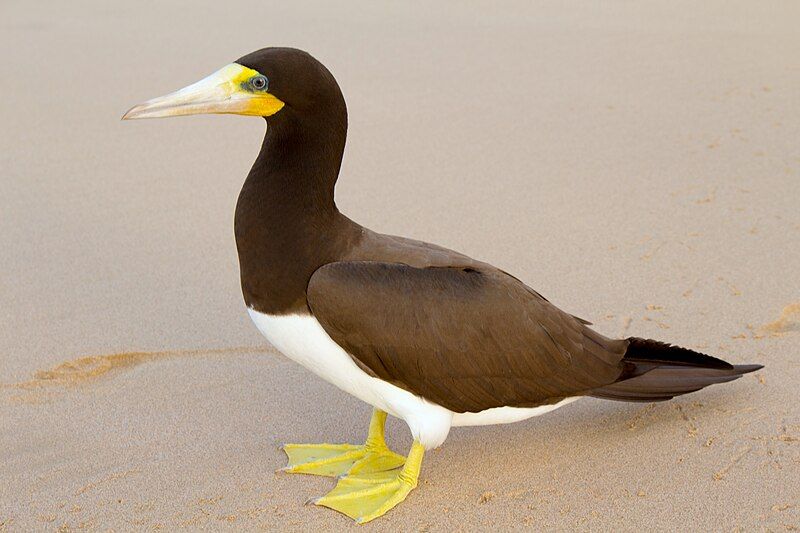
The brown booby is a large seabird from the Sulidae family of birds, sometimes referred to as the booby family.
It is one of the most common and widespread species from the family, and it has a pantropical range, meaning that its habitat covers a wide range, from tropical to subtropical regions, and it overlaps with other species of boobies.
Brown boobies are known for their gregarious nature, and they are often seen commuting and foraging at low heights over inshore waters, which is a type of water body close to the shoreline.
They are adept at searching for food in these waters, and it is a major part of their diet. Brown boobies are also known to move around in large flocks, and they are often seen in large numbers in areas where they gather.
| Kingdom | Animalia |
| Phylum | Chordata |
| Class | Aves |
| Order | Suliformes |
| Family | Sulidae |
| Genus | Sula |
| Species | S. leucogaster |
7. Osprey
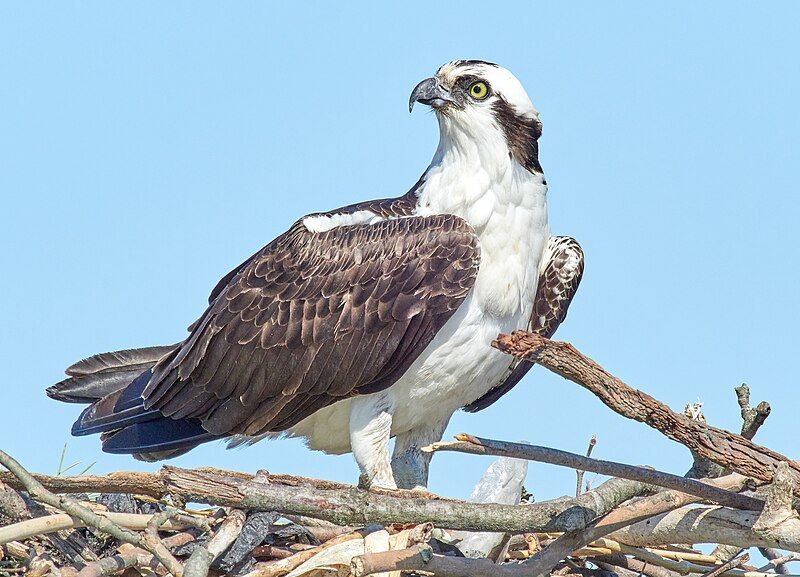
The Osprey is a bird of prey that is found in many parts of the world. It has many names such as sea hawk, river hawk, and fish hawk, but all refer to the same species. This bird of prey has a cosmopolitan range, meaning it can be found in many regions.
It is a large raptor, measuring up to 60 cm in length and its wingspan can reach up to 180 cm. It has a brownish color on its upper parts, and its head and underparts are predominantly grey. It is diurnal, meaning it is active during the day, and it feeds on fish.
| Kingdom | Animalia |
| Phylum | Chordata |
| Class | Aves |
| Order | Accipitriformes |
| Family | Pandionidae |
| Genus | Pandion |
| Species | P. haliaetus |
8. Masked Booby
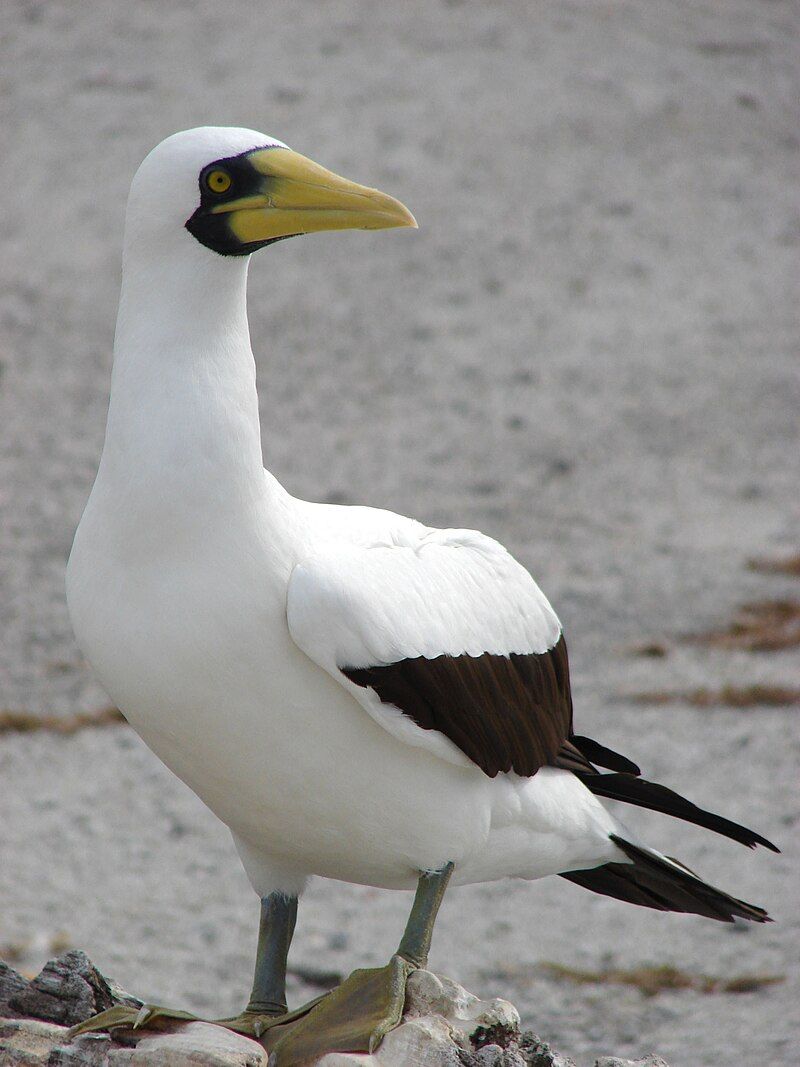
The masked booby is a large seabird of the booby and gannet family, Sulidae. It is commonly referred to as the masked gannet or the blue-faced booby.
This species of bird was first discovered by the French naturalist René-Primevère Lesson in 1831 and is one of six species of booby in the genus Sula.
The masked booby is a tropical bird, usually found in the Pacific Ocean, but can also be seen in the Atlantic Ocean, and the Indian Ocean. It has a long, pointed beak and a distinctive blue face. Its body is predominantly white, with a black mask covering its eyes.
Its wings are wide and pointed, and its legs are long and powerful. The masked booby feeds mainly on fish, which it catches by plunge-diving from great heights. It can dive up to 80 feet into the water and often hunts in flocks.
It is also known to forage on the ground and on the surface of the water. The masked booby breeds in colonies on small islands and on rocky outcrops. It nests on the ground, laying one to three eggs at a time.
The eggs are incubated by both the male and female and the chicks are fed regurgitated food from the adults.
The masked booby is considered to be a near-threatened species due to its vulnerable population size and its limited range, which is threatened by human activity and climate change.
Conservation efforts are underway to protect the species, and the International Union for Conservation of Nature (IUCN) has listed it as an endangered species.
| Kingdom | Animalia |
| Phylum | Chordata |
| Class | Aves |
| Order | Suliformes |
| Family | Sulidae |
| Genus | Sula |
| Species | S. dactylatra |
9. Wandering Tattler
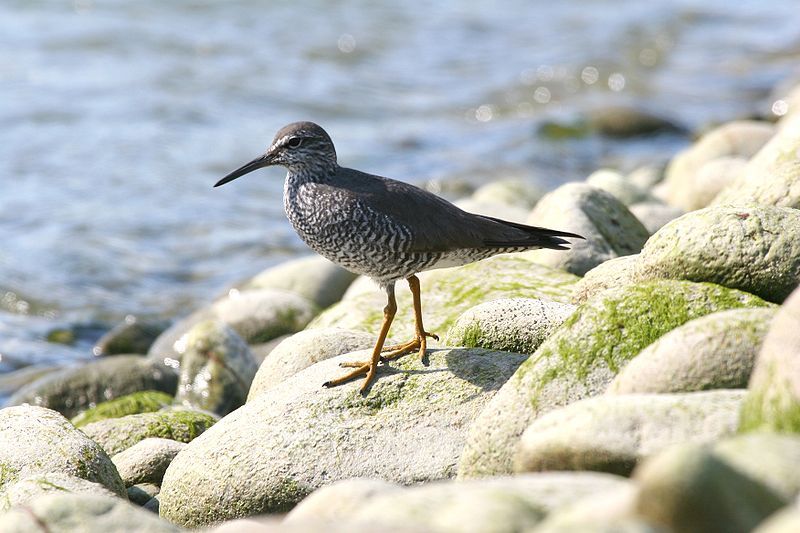
The Wandering Tattler is a species of wading bird found in coastal and inland areas throughout the world. It is easily identified by its medium size and grayish-brown upperparts. The bird also has a distinctive pattern on its wings, with white spots and dark barring.
The Wandering Tattler is closely related to the Gray-tailed Tattler, another species of wading bird found in the same areas. The two species are very similar in appearance, both having grayish-brown upperparts and a distinctive pattern on their wings.
The main difference between them is that the Gray-tailed Tattler has a shorter bill than the Wandering Tattler, and its wing pattern is more finely marked. The Wandering Tattler is also the larger of the two, reaching lengths of up to 39 cm.
As its name suggests, the Wandering Tattler is also a migratory species, traveling long distances across oceans and continents in search of food.
The bird has an array of calls that it uses to communicate with other birds in its flock and to advertise its presence during courtship. The Wandering Tattler can be found in a variety of habitats including coastal areas, wetlands, and even woodlands.
It feeds mainly on aquatic invertebrates such as insects, crustaceans, and mollusks, which it finds in the mud and shallow waters.
| Kingdom | Animalia |
| Phylum | Chordata |
| Class | Aves |
| Order | Charadriiformes |
| Family | Scolopacidae |
| Genus | Tringa |
| Species | T. incana |
10. Ruddy Turnstone
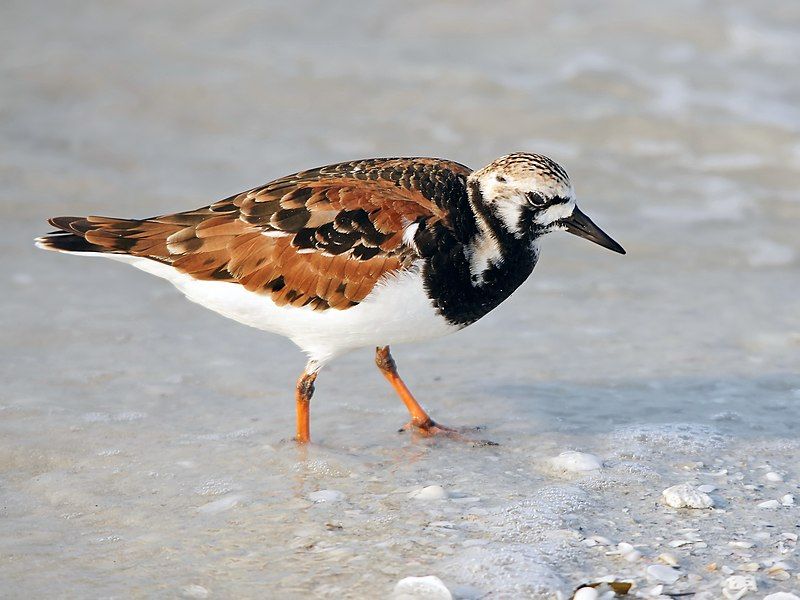
The ruddy turnstone is a species of wading bird that is found across the globe. It is part of the genus Arenaria, which consists of two species of turnstones.
The ruddy turnstone is classified in the sandpiper family Scolopacidae, but it used to be placed in the plover family Charadriidae. This small bird measures between 16 and 17 cm in length and has a wingspan of 31 to 34 cm.
Its upperparts are reddish-brown, while its underparts are white. It has a white line running from its eye to its bill, and its legs and feet are black. In terms of behavior, the ruddy turnstone is quite active and can often be seen running along the shoreline.
It feeds on small invertebrates such as mollusks, worms, and crustaceans which it finds in the sand and mud. During the breeding season, the ruddy turnstone will migrate to the Arctic tundra to breed.
The nest is usually a shallow scrape in the ground which is lined with vegetation. The female will lay up to four eggs which are incubated for around 21 days. When the chicks hatch they are ready to leave the nest within a few days.
The ruddy turnstone is listed as a species of Least Concern by the International Union for Conservation of Nature, due to its widespread range and large population. It is a fairly common sight along shorelines, and it is a popular subject for birdwatchers.
Despite its popularity, its population is declining in some areas due to overharvesting, habitat loss, and pollution. Therefore, it is important to protect this species and its habitat to ensure its continued survival.
| Kingdom | Animalia |
| Phylum | Chordata |
| Class | Aves |
| Order | Charadriiformes |
| Family | Scolopacidae |
| Genus | Arenaria |
| Species | A. interpres |
11. Wedge-tailed Shearwater
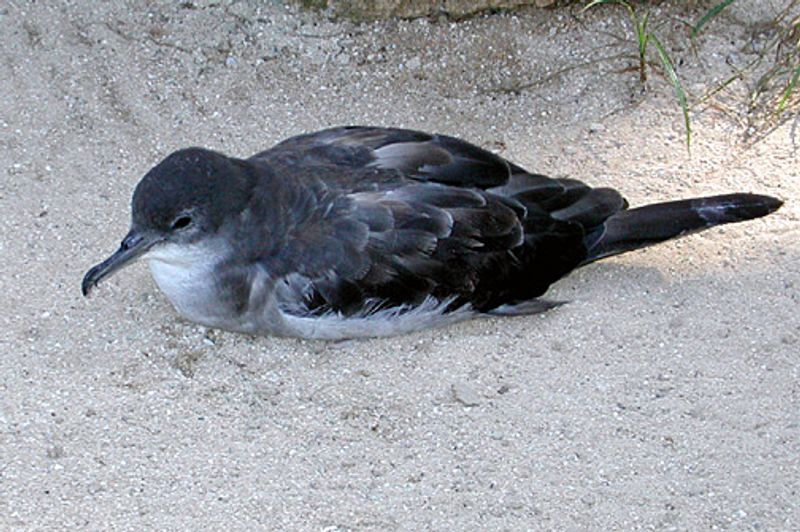
The wedge-tailed shearwater is a medium-large seabird belonging to the Procellariidae family. It is one of the species of shearwater known as a ‘muttonbird’, alongside the sooty shearwater of New Zealand and the short-tailed shearwater of Australia.
These birds have wings adapted for gliding on air currents over long distances, which is why they are referred to as ‘shearwaters’. They are typically found in the Southern Hemisphere, particularly in the waters off of Australia, New Zealand, and Chile.
The wedge-tailed shearwater is a distinctive bird, with a brown back and a white underside. The most distinguishing feature is its long, wedge-shaped tail. The bird can grow up to 15 inches in length and has a wingspan of up to 40 inches.
It has a black bill and legs, and its eyes are a deep yellow color. The wedge-tailed shearwater hunts small fish and squid, which it catches by swooping down from the sky.
It is a sociable bird and often forms large flocks, which can be seen over the ocean surface or even perched on rocks near the shore. It is an important part of the food chain, as its diet helps keep the ocean balanced and healthy.
The wedge-tailed shearwater is not just an important ocean species, but also an important cultural figure in Australia and New Zealand. The birds are hunted for their meat, known as ‘muttonbird’, which is a popular delicacy in these two countries.
In some places, the shearwaters are also hunted for their feathers, which are used to make traditional clothing and jewelry.
| Kingdom | Animalia |
| Phylum | Chordata |
| Class | Aves |
| Order | Procellariiformes |
| Family | Procellariidae |
| Genus | Ardenna |
| Species | A. pacifica |
12. Sanderling
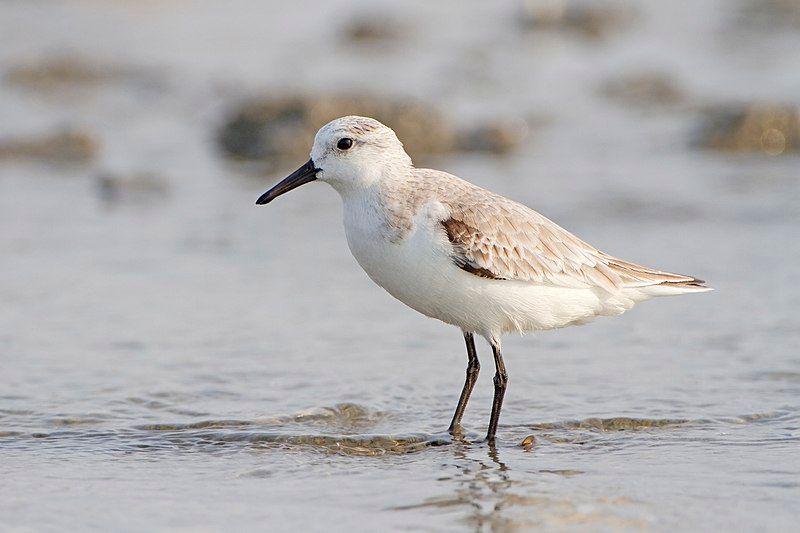
The sanderling is a small migratory bird commonly seen on the shorelines of oceans and large bodies of water. It belongs to the family Scolopacidae and is scientifically named Calidris alba.
The name “sanderling” comes from Old English and literally translates to “sand-ploughman,” referring to the behavior of the bird as it ploughs the sand with its feet in search of food.
The genus name, Calidris, is derived from the Ancient Greek term kalidris or skalidris which was used by Aristotle to describe grey-coloured waterside birds. The specific name alba is Latin for “white”, which is a common color of the sanderling’s feathers.
The sanderling is a small wading bird, typically measuring between 18 and 20 centimeters in length. Its upper body is usually grey-brown and its undersides are white, which gives it a distinct two-tone coloring.
It has long legs and a short, thin bill which it uses to dig through the sand in search of small invertebrates such as mollusks, worms, and crustaceans.
The sanderling is a highly active bird and can be seen running up and down the shoreline in an attempt to catch up with the receding waves. The sanderling is a widely distributed species, occurring on the coasts of both the Atlantic and Pacific Oceans.
It is a migratory species and will fly south during the winter months to warmer, more hospitable areas. During the summer months, it will remain in the northern regions, breeding on the coasts of Canada, Greenland, and other northern countries.
The sanderling is a highly sociable species, often occurring in large flocks on the shoreline. It is an important part of the coastal food chain and an important indicator of the health of coastal ecosystems.
| Kingdom | Animalia |
| Phylum | Chordata |
| Class | Aves |
| Order | Charadriiformes |
| Family | Scolopacidae |
| Genus | Calidris |
| Species | C. alba |
13. White-tailed Tropicbird
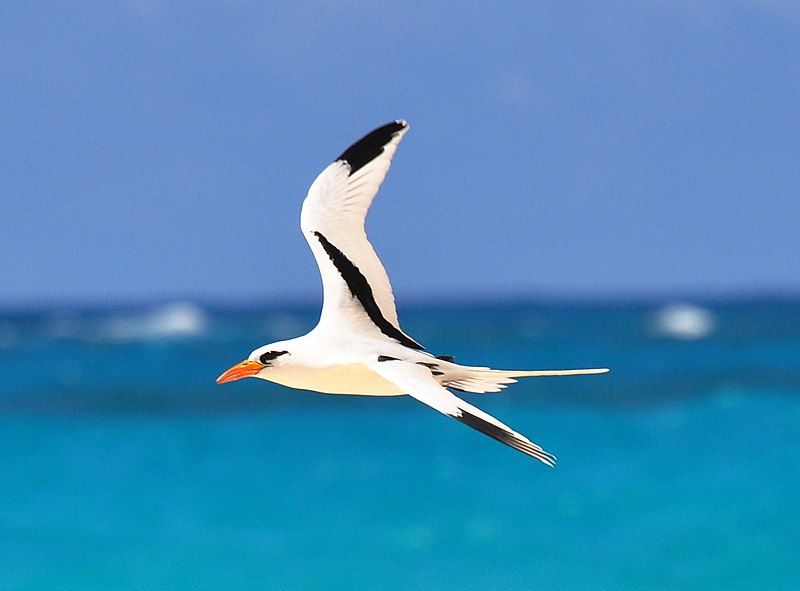
The white-tailed tropicbird is a species of seabird that is found in the tropical oceans of the Atlantic, Pacific, and Indian Oceans. It is part of the order Phaethontiformes, which includes three closely related species of seabirds.
This species is the smallest of its kind, making it stand out among its peers. The white-tailed tropicbird has a white body, a long forked tail, and a yellow crest. Its wingspan can reach up to 40 inches, and its wings are black with white markings.
This species is known for its spectacular courtship displays, during which males perform a series of aerial acrobatics to attract a mate. White-tailed tropicbirds are territorial and build large, shallow nests in trees or on the ground.
They feed mainly on fish and squid, but will also eat crustaceans and other small animals. They are generally found in pairs or small groups, and will often gather around fishing boats to scavenge for food.
The white-tailed tropicbird is an important part of the marine ecosystem, helping to keep the oceans healthy by controlling the population of small fish and other prey. It is also an important source of food for other seabirds and marine predators.
This species is currently listed as Least Concern on the IUCN Red List of Threatened Species, however, its population is declining due to habitat loss and climate change.
| Kingdom | Animalia |
| Phylum | Chordata |
| Class | Aves |
| Order | Phaethontiformes |
| Family | Phaethontidae |
| Genus | Phaethon |
| Species | P. lepturus |
14. Lesser Frigatebird
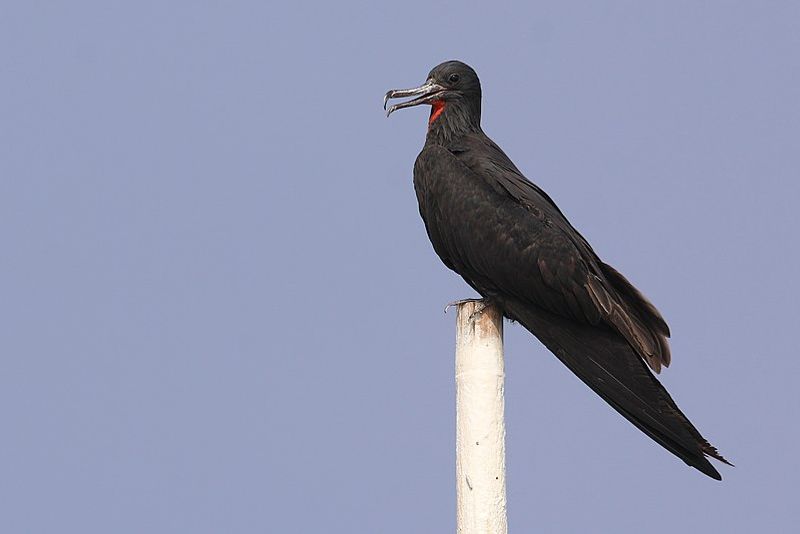
The lesser frigatebird is a species of seabird belonging to the Fregatidae family of frigatebirds. It is the smallest of its kind, measuring roughly 75 cm in length.
It can be found in tropical and subtropical regions of the Indian and Pacific Oceans, as well as along the Atlantic coast of Brazil. The lesser frigatebird is a distinctive species of seabird, with long, pointed wings and a forked tail.
Its feathers are predominantly black, with a white patch on its chest and a white band across the tip of its wings.
The male of the species is easily recognizable due to its bright red gular pouch (the area under its beak which it swells during courtship displays). The lesser frigatebird is a highly sociable species, often found in large flocks.
During the breeding season, groups of birds can often be seen performing acrobatic displays in the sky.
These displays involve the birds repeatedly diving and soaring in an attempt to attract a mate. The lesser frigatebird feeds on fish, squid, and crustaceans which it catches by plunge-diving into the ocean.
It also scavenges food from other seabirds and will sometimes follow fishing vessels to catch scraps thrown overboard. Overall, the lesser frigatebird is a fascinating species of seabird that can be found in tropical and subtropical regions of the Indian, Pacific, and Atlantic Oceans.
It is easily recognizable due to its small size and distinct coloration, and it is highly sociable, often seen in large flocks performing courtship displays.
It catches its prey by plunge-diving into the ocean and will also scavenge food from other seabirds and fishing vessels.
| Kingdom | Animalia |
| Phylum | Chordata |
| Class | Aves |
| Order | Suliformes |
| Family | Fregatidae |
| Genus | Fregata |
| Species | F. ariel |
15. Black Bellied Plover
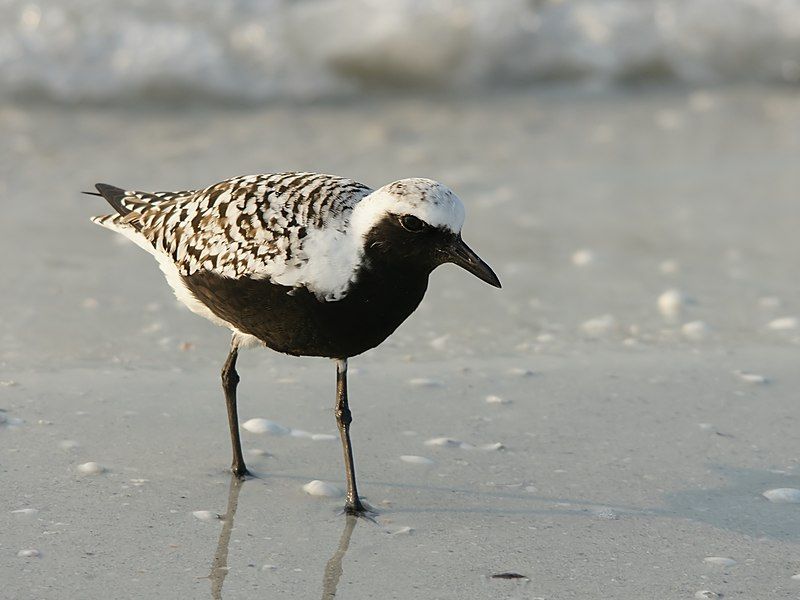
The grey plover is a species of bird that is found across the world. It is also known as the black-bellied plover in North America. This species of plover is quite large, and it breeds in the Arctic region.
It is a long-distance migrant, meaning that it travels great distances throughout the year. As such, it has a nearly worldwide coastal distribution when it is not breeding. This means that it is found in coastal areas all around the globe when it is not breeding in the Arctic.
The grey plover is an important species of bird that plays an important role in ecosystems around the world.
| Kingdom | Animalia |
| Phylum | Chordata |
| Class | Aves |
| Order | Charadriiformes |
| Family | Charadriidae |
| Genus | Pluvialis |
| Species | P. squatarola |
16. Sharp-tailed Sandpiper
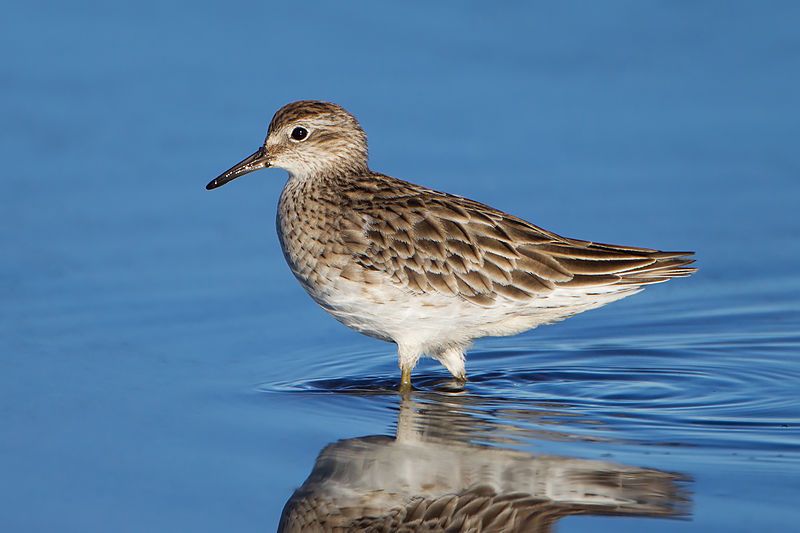
The sharp-tailed sandpiper is a unique migratory shorebird that breeds mainly in Siberia during the summer months. It is a small to medium-sized wader and is found in many parts of the world during its annual migration.
During the winter months, the sharp-tailed sandpiper migrates to Australia in order to spend the colder months in a warmer climate.
This species of shorebird is a highly effective migrant, as it can quickly adjust its migration patterns in order to take advantage of seasonal conditions.
The sharp-tailed sandpiper is a very hardy bird, able to survive the extreme temperatures and conditions of its winter migration.
The sharp-tailed sandpiper is an important species of migratory shorebird and plays a vital role in the ecological balance of both its winter and summer habitats.
| Kingdom | Animalia |
| Phylum | Chordata |
| Class | Aves |
| Order | Charadriiformes |
| Family | Scolopacidae |
| Genus | Calidris |
| Species | C. acuminata |
17. Franklin’s Gull
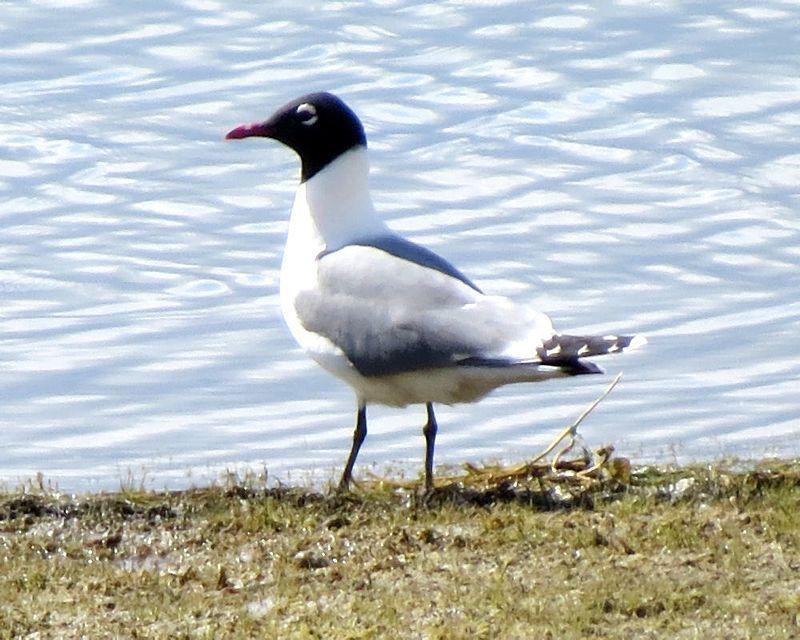
Franklin’s gull is a small species of gull that is part of the genus Leucophaeus. The genus name is derived from Ancient Greek, with leukos meaning “white” and phaios meaning “dusky”.
The specific name pipixcan is derived from the Nahuatl language, which is an indigenous language of Mexico and Central America, and it literally translates to “a type of gull”.
This species of gull has a white head, neck, and underside, along with dark gray wings, back, and tail. The Franklin’s gull is often seen in large flocks, and it is a frequent sight in inland lakes and marshes during migration.
This species of gull is also known for its complex courtship rituals, and its impressive acrobatic abilities when in flight.
| Kingdom | Animalia |
| Phylum | Chordata |
| Class | Aves |
| Order | Charadriiformes |
| Family | Laridae |
| Genus | Leucophaeus |
| Species | L. pipixcan |
Conclusion
Palmyra Atoll is a unique and biodiverse ecosystem, and birds are an integral component of this environment. Several species of birds, including several endemic species, are found in the Atoll, making it an important habitat for these birds.
The Atoll is also an important breeding ground for many species, as the Atoll provides the perfect conditions for nesting and raising young.
Through conservation efforts and protection measures, Palmyra Atoll is an invaluable asset to the birds that inhabit its waters, and to the world as a whole.